There's still a post in the works about why I felt the need to leave PATSP for a month, but at first, I was kind of working out what had been going on while I tried to write the explanation. We're now at the point where I've pretty much worked out the reasons and am just trying to decide how to phrase it in such a way as to not sound like a whiny, entitled brat. Probably I'm also failing, of course.
I was sort of feeling like it was time to post something again regardless, therefore this post.
When watering last week, I knocked over the Aglaonema that had produced fruits, and one of the three fruits came off. It may not have been ready to plant yet, but I figured I had nothing to lose, so I stuck it in vermiculite, and we'll see what happens. The most surprising thing about it was how large it was; the flesh of the fruit was only a thin layer around the seed. 
The picture quality is awful, because I forgot about the fruit for a few hours after I watered, and by the time I remembered again, it was night, so I had to use the flash. It was smooth, sort of tan-green, with a silky sheen to it, and was about 5/8 of an inch (15 mm) long. 
I have no idea if it will sprout; I've never tried this before. Aroid.org's recommendations for Aglaonema don't include vermiculite; they suggest varying combinations of (peat or coir) + (perlite or sand). Ufl.edu has similar recommendations, though they say sphagnum peat or sphagnum moss only. The silkiness I described may be due to a seed membrane that I should have removed but didn't; I wasn't watching for that at the time so I don't know for sure.
I haven't checked on the seed yet to see whether it's doing anything, but the odds are that it isn't. Aglaonema germination is slow. The best-case scenario is 2 weeks, and 4-12 weeks is more typical. If anything happens, I'll let you know. The other two berries are still on the plant. One is beginning to deflate a little (it was maybe damaged in the fall, even though it didn't actually come off the plant), and I should probably plant it soon; the other one I'll leave on for as long as I can, since I'm not sure when the fruits are officially ripe. (Most sources say the fruits turn red when ready, but "red" is hard to define.) We'll see how it goes. And next time I'll try something other than vermiculite, just in case that makes a difference.
I have a couple other Aglaonemas blooming now, for some reason -- 'Emerald Holiday' has had a flower open for a few days now, for weeks now 'Diamond Bay' has been producing flowers that don't open up so they're useless for cross-pollination, and 'Emerald Bay' is only beginning to produce a few flowers now. So there's a slight chance of getting a cross with 'Emerald Bay' and something else, but I'm not optimistic. I think the other plants' flowers will be gone by the time 'Emerald Bay' gets around to opening.
Wednesday, December 28, 2011
Random plant event: Aglaonema seed
Wednesday, December 21, 2011
Music Video: "Chiron Beta Prime" (Jonathan Coulton, w/ ASL interpretation from Stephen Torrence)
Is today the solstice? I know it's around now, at least.
So hi. How are y'all doing? I'm okay. Sorry if I worried anybody. I really wasn't having a nervous breakdown, whatever rumors you've heard. There are much longer, whinier, more personal, and somewhat abstract (in places) explanations for the abrupt hiatus, but it really does basically condense down to, I was burned out on blogging and wanted to have time to play Sims, which I never had time to do previously. I am now seeing signs that I'm burned out on Sims, or at least approaching burn-out, so regular blogging will probably be resuming at some point in the next couple weeks. It may take me a while to work back up to daily posting, though. Like, don't expect posts in the next couple days, is what I'm saying. Among other things.
This is a video I had previously scheduled for this week, because it's holidayey without being one of the standard Christmas songs. I pretty much hate all the usual Christmas music, since 2005 or so, because of having been forced to listen to it during a retail job (and then again in 2006, in a similar but different retail job), and basically never want to hear any of those songs again in my entire life and I'm not even exaggerating. But nobody writes light jazz versions of "Chiron Beta Prime" for supermarkets, or uses it to sell toilet paper -- at least not yet -- so I approve of it.
Also I would be remiss if I neglected to mention the one semi-exception to the Christmas music hatred, this mashup of "Rudolph the Red-Nosed Reindeer" with The Police's "Roxanne." (And even it's not something I'd want to listen to very often.) I'm not sure the video actually improves the experience of hearing the mashup, but embedding a video is the easiest way I have of sharing music, so:
The next post will happen when it happens.
Sunday, November 27, 2011
Extension
I need a little more time, I think, before I come back. Don't know how long it'll be, and I hesitate to give myself any new deadlines for fear I won't be able to keep them. I'll explain eventually.
Tuesday, November 22, 2011
Random plant event: Aglaonema; Hiatus
Hi.
So, um, everything/everyone is okay, but I'm feeling very close to burn-out and need to take a few days off. (Sorry if this ruins anyone's life. It's unintentional.) I had a big thing written here with the four reasons why, but luckily, I realized that y'all probably don't care about the reasons so long as everything's okay, which it is, plus they weren't even especially interesting reasons, so even if you would ordinarily be inclined to care, you still wouldn't care.
Planning to be back Sunday.
As for today's plant-related content, the Aglaonema fruits I reported on in July are showing signs of ripening now. 
A lot of the Aglaonemas bloomed this summer, at more or less the same time, and I tried making random crosses with everything that happened to be flowering at any given moment, but this is the only set of fruits I managed to get. This page suggests that I might have had better luck if I'd wrapped the flowers with wet paper towels and plastic after making the crosses -- apparently 100% humidity is important. Next year, perhaps.
I don't know exactly when these are fully ripe and ready to plant, but I've been having reasonably good luck with Anthurium lately (65 seedlings growing in vermiculite, plus I started about 100 more seeds a few days ago), and I figure Aglaonema is probably at least kind of similar. The mother is 'Maria;' the father I don't know, because I was basically trying to cross anything and everything, but there's a pretty good chance that it's also 'Maria.' In which case the seedlings will be boring and the whole project pointless, but I won't know if it was a waste of time or not for another 12-24 months. (The link above says you can't really know if you've produced a cross that's worth propagating until the plant's been growing for about a year, but I'm guessing that indoors, it'll be slower, so maybe 2 years.) I'll let you know how it goes.
Monday, November 21, 2011
Pretty picture: Cymbidium Starbright 'Sirius'

Lots of Cymbidiums for sale lately in the stores here, but they're all super-expensive. (The cheapest I saw was $50.) This means I will probably never find out whether I can grow a Cymbidium, but that's probably okay: based on my experiences with other orchids, I suspect the answer is yes, but not well.
I really like the way they look, though.
Saturday, November 19, 2011
Saturday morning Sheba and/or Nina picture
When it got hot this summer, I stopped walking Sheba. I couldn't handle it, and she's black, and in a fur coat, so she's not crazy about going out in the heat either. We'd still go out in the mornings, and I'd throw a tennis ball for her to fetch, but that was it. It saved me a lot of time, she still seemed to be getting adequate exercise, and I didn't have to get heat exhaustion first thing every morning, so it worked out great.
However. This meant, also, that Sheba's nails weren't getting worn down by walking on concrete and gravel. We can't cut her nails for her -- she will permit us to touch her feet now, which she wouldn't when we first got her, but she still won't let us hold her feet, and she gets pretty freaked by any objects near her feet.1 So, during the morning tennis-ball throwing, she was catching her nails in the lawn and breaking them a lot. (Possibly "a lot" is inaccurate, but after the scary first one a while back, which I wrote about, she's broken one at least two more times. I don't know if it's the same nail or not, though I think I've read that once a nail's broken once, it's more prone to breaking again ever after.) Which means that I've resumed the walks, though I'm not terribly happy about it. I'm not sure if this is a particularly good way to deal with the nail-splitting problem, but it at least doesn't appear to be making things any worse. 
On the other hand, when we go out, she spends basically the whole walk with her hackles raised, as in the above photo. This is new: she didn't do this in the spring.
Googling was inconclusive: ordinarily it's a sign of fear or aggression, but I read that hackle-raising also sometimes happens when the dog is surprised or nervous. She certainly isn't acting particularly aggressive when it happens -- usually there's not even a person or dog around to be aggressive towards -- and it seems to happen particularly often when she's smelling something really intently. Perhaps she's just surprised. A lot.
-
1 It's not like her nails never get trimmed; we've just never been the ones to do it. Once at the vet's, once at a pet store (which sounded like it was a terrible experience for all involved; I wasn't there), maybe another time at another pet store, I can't remember.
Friday, November 18, 2011
How to Take Transmitted Light Photographs
This one is for Derek Powazek, who left a comment in the most recent transmitted-light post asking for a "'behind the scenes' type post on how you shoot these photos."
Initially I resisted the idea, because I didn't think it was really complicated enough to write a post about. I mean, really, you just get a light source, a camera, and a leaf, and you put the leaf between the light source and camera and take pictures. Nothing that complicated about it. But as I thought have I learned anything else about the process that would be useful to share?, I managed to make it complicated anyway. Yay me.
So the first thing is, you need a camera, light source, and leaf.
I have no advice about the camera part. I don't know about cameras; I've only ever had relatively cheap point-and-shoot ones. I do know you're going to need something with a very short focal length, so make sure there's a macro mode.
I have some advice about leaves. Characteristics that tend to make leaves suitable for transmitted light photos:
1. Thin (non-succulent).Thick, succulent leaves can sometimes produce serviceable photos, but to see the venation, you need a leaf that's thin enough for light to shine through. Broad leaves are useful mostly because the leaf has to be big enough to block the light source from shining on the lens. If it's not, you get lens flare.
2. Broad.
3. Variegated.
4. Flat(-tish).

Variegated leaves tend to be more interesting, or at least more colorful and dramatic, though that's a matter of personal taste. Finally, extremely curly, quilted, or twisted leaves tend to make poor subjects because only part of them can be in focus. Sometimes that works out well anyway, but I prefer flatter leaves.
The "leaves" don't always have to be leaves, either -- I've taken serviceable pictures of spathes (Spathiphyllum, Anthurium), phyllocladodes (Schlumbergera), petals/sepals (Abutilon, Tulipa, Hemerocallis), and cataphylls (Zamioculcas) before. Dead leaves also have their charms, sometimes, in the right situations.
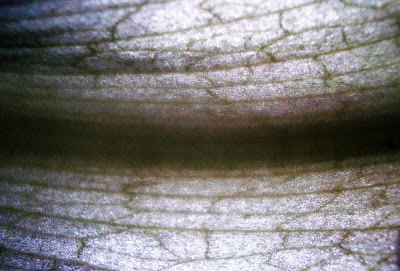
Almost any leaf can be made to work, but I particularly recommend Dieffenbachia, Caladium, Alpinia/Zingiber, Calathea, Alocasia, Zantedeschia, Strelitzia (especially S. reginae), Solenostemon, Musa, Anthurium, Codiaeum, Begonia, and Phlebodium.
The light source that works best for me is sunlight. That said, it's totally possible to get a decent image out of an artificial light; the main problem is that the color balance can come out really strange, and sometimes it can be hard to fix after the fact, like in this picture:

This happens less often with sun.
One wants to minimize reflected light as much as possible when doing this. The appeal of transmitted light photos is that the colors are highly saturated and at high contrast; if there's light coming from behind the camera, this will reflect back into the lens and wash out the color. This can also be a problem if you're taking pictures outside in a bright area, or even if you're taking pictures while wearing light-colored clothing. Wear dark clothes, and as much as possible, shoot from a dark location towards a light one.

Very light-colored leaves (e.g. some of the Dieffenbachias with white centers, Spathiphyllum spathes, pretty much any of the chartreuse cultivars of anything) tend to be difficult to get. This might be specific to my camera. It's often possible to manipulate the image afterward to increase the contrast and get something interesting out of it anyway, but not always.
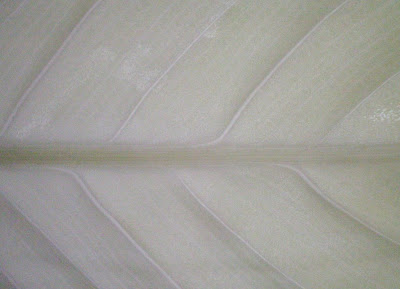
 Like here (Spathiphyllum 'Golden Glow' or whatever, spathe), for example. The actual spathe is basically pure white, but in the process of cranking up the contrast so there was something to look at, all this yellowish stuff showed up. This was fixable too (reduce the saturation); I don't know why I didn't.
Like here (Spathiphyllum 'Golden Glow' or whatever, spathe), for example. The actual spathe is basically pure white, but in the process of cranking up the contrast so there was something to look at, all this yellowish stuff showed up. This was fixable too (reduce the saturation); I don't know why I didn't.I usually get the best results when the light source is hitting the leaf exactly perpendicular to the leaf surface. If the light comes in at an angle to the leaf, you'll wind up with shadows everywhere. If the leaf is basically flat, this can sometimes be a good effect; if it's at all cupped, quilted, or otherwise uneven, though, I don't like it as well. With some extremely-textured leaves (like Pilea mollis 'Moon Valley,'), you're going to get shadows no matter what you do.
.jpg)
If the camera is pointed at an angle to a flat leaf, you'll have one area that's in focus, and then out-of-focus everywhere else. Sometimes that works, sometimes it doesn't. Usually, the closer you can get to aiming the camera perpendicular to the leaf surface, the better.

I'm usually trying to get these pictures while holding the leaf in one hand and the camera in the other. This means that for most shots, both my hands are moving, and the image comes out blurred. The solutions I've come up with for this:
1. Keep your hands touching one another, so that if one moves, the other has to move with it. This doesn't eliminate motion blur, but it keeps both hands moving in the same direction, so you get rid of some of it.Manipulating the images afterward is also part of the gig; I use Irfanview. I rotate the image so that the base and petiole of the leaf are on the left and the tip of the leaf is on the right, straighten it as much as possible so the midrib (if present) is strictly horizontal, crop the image, and then adjust the color until it looks right. All these steps are pretty easy to do in Irfanview, though cropping is sometimes kind of a pain, because of a quirk that happens when the image size is reduced down to about 20-25% of normal. A typical process goes something like this (using a bract from an unidentified Euphorbia pulcherrima variety as my example):
2. Tape the leaf to something. I've had decent luck taping leaves to the shade of the fluorescent light on Nina's terrarium; I've also been able to tape leaves to windows at certain times of day. If you use a tiny piece of tape, and only on the very edges of the leaf (which won't show in the picture anyway), this can be very helpful. This doesn't work when there's a screen on the window, though:Dieffenbachia 'Camouflage,' photographed against a screened window. It's an interesting effect, but not really the kind of thing I'm usually going for.
3. Find a tripod. I often stack up soup cans and rest the camera on the cans when taking pictures. This doesn't reduce camera motion entirely, but it helps, and it's easy to set up, take down, and adjust. Plus then you can have soup when you're finished taking pictures.
4. Take lots of pictures. Sometimes you just have to take 25 pictures and hope that one of them turns out.
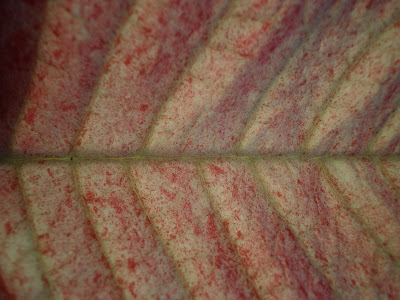
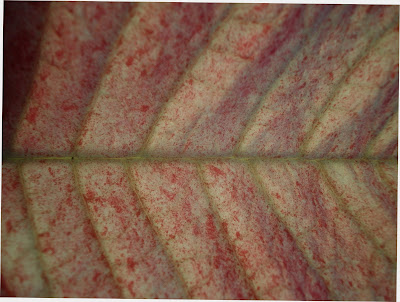 After rotating it slightly to get the midvein horizontal.
After rotating it slightly to get the midvein horizontal.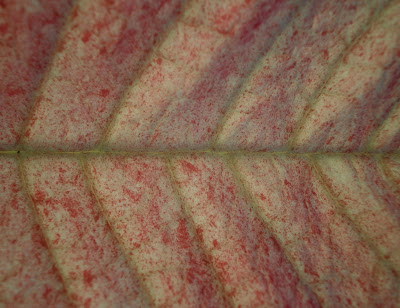 Cropped to remove the shadow of another bract on the left.
Cropped to remove the shadow of another bract on the left.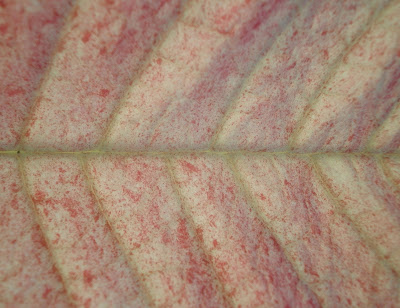 Lightened with the "gamma correction" function. (I don't know what gamma is or why it needs correcting, but this gives better results than adjusting the brightness.)
Lightened with the "gamma correction" function. (I don't know what gamma is or why it needs correcting, but this gives better results than adjusting the brightness.)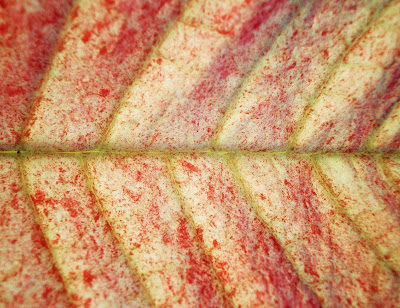 I increased the contrast until it looked more or less right.
I increased the contrast until it looked more or less right.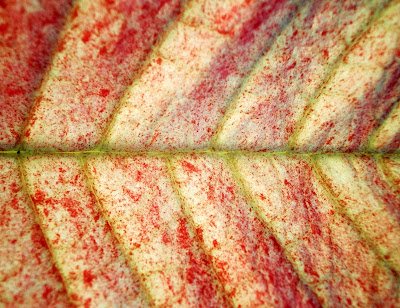 I used the auto-adjust color, which increased the contrast a little more and darkened the image slightly.
I used the auto-adjust color, which increased the contrast a little more and darkened the image slightly.There are often other steps involved in the photo processing: if everything's too yellow, I can turn up the blue a little; if it's washed-out, I can increase contrast; if it's a little fuzzy, I can sharpen the image. That sort of thing. Often, something that looks just fine on my computer will look like crap once I upload it to the blog, but them's the breaks.
So I think that's all I've got. Go. Go try it for yourself.
Thursday, November 17, 2011
Monstrosithurium
Remember this spring, when we all got to bemoan the existence of dye-injected orchids? (Phalaenopsitrocity! Dendrobomination!)
Well, certain douchemonkeys have decided that those were such a great idea that they're wanting to do the same thing with Anthuriums.
Presently, one "breeder" is offering a white Anthurium that's been infused with blue or yellow dye. The picture at the link doesn't actually look that terrible, but I'm guessing it's also been very carefully manipulated. The dyed Dendrobium and Phalaenopsis probably look very nice too, if there's enough Photoshop involved.
I have no hope of being able to stop dyed Anthuriums from happening (indeed, my guess is that in the future, all plants will be available in every color of the rainbow, and every one of them will rebloom white), but I figured I should at least warn y'all that this is on the way.
New Frontiers in Christmas Decor
This . . . 
was at the ex-job yesterday. The flash washed out the purple lights, so this isn't quite how it really looked (I've tried to compensate by turning down the green a little), but perhaps you get the idea anyway. It was very, y'know, striking, so I said so to a former co-worker, who was all like, "oh, yeah, the hooker tree." And then there was a discussion with her and another employee about whether "hooker" was appropriate or not. (The other employee pointed out that we had no reason to think that the tree actually slept around -- all we actually know about it is that it has flamboyant tastes -- and said she preferred "burlesque Christmas tree." I like "burlesque" better too. And I'm pretty sure I now like the other employee, who I'd not previously met.)
You know you're having a nice day when you get to talk about whether or not an artificial Christmas tree is slutty.
For my part, I was initially horrified, but the more I look at it, the more I think it's one of those so-wrong-it's-cool things. Your mileage will vary.
In more houseplant-relevant Christmas merch, we have this:
Poinsettias don't fall apart and die fast enough on their own, so we have to speed it up by sticking them in tiny, no-drain spherical pots full of sopping wet peat. The wooden sticks don't seem to serve any useful purpose; they read "http://www.optimara.info" on one side, but that address goes to a page displaying African violet varieties (which, judging by the page's formatting, was last updated in 2001) and "easyGrowing...easyCare" on the other, none of which is true. Unless the ellipsis stands in for missing words, like:
easyGrowing is not at all what this plant is, even under ideal circumstances, nor are there any imaginable circumstances under which this plant, as it is currently being grown, could be construed to be easyCareIn that case, then the ellipsis, at least, might be true.
This, I think, is just kind of self-evidently horrible and wrong, but everything involving poinsettias tends to strike me as horrible and wrong, so whatever. I'm not sure what could possibly happen to launch these poinsettia-balls into so-revolting-it's-awesome territory (Glitter? Bows? Plastic neon bows covered in glitter? Artificial ivy spilling out of the bottom? Little metal stars bobbing above the plant on springs? Plastic neon glitter-covered bows on springs? Spray-paint? LEDs around the inside rim of the pot? Plastic neon stars encrusted with blinking LEDs, on bobbing springs, with a tiny mechanical Santa walking in circles through the artificial ivy spilling out of the glitter-covered metallic-painted spherical pot?), but I enjoyed thinking about the possibilities.
Wednesday, November 16, 2011
Rumble Among the Jungle Results (all matches)
Winners are in bold; the numbers following are the votes and percentages, in the same order. The pie charts show which families were represented among the contestants at various stages of the competition.

Match 1.1
Kalanchoe tomentosa (panda plant) vs. Clivia miniata cvv.
53-74 (42%-58%)
Match 1.2
Peperomia obtusifolia cvv. (baby rubber plant) vs. small hybrid Vriesea cvv.
58-65 (47%-53%)
Match 1.3
Ficus elastica (rubber plant) vs. Cryptanthus cvv. (earth star)
56-68 (45%-55%)
Match 1.4
Yucca guatemalensis (spineless yucca) vs. Tradescantia pallida (purple heart)
39-81 (33%-68%)
Match 1.5
Saintpaulia cvv. (African violet) vs. Hemigraphis exotica (purple waffle plant)
82-27 (75%-25%)
Match 1.6
Cyclamen persicum (florists' cyclamen) vs. Echinopsis spp.
45-72 (38%-62%)
Match 1.7
Pachypodium spp. (Madagascar palm) vs. Epipremnum aureum cvv. (pothos)
47-68 (41%-59%)
Match 1.8
Scindapsus pictus (satin pothos) vs. Crassula ovata/argentea/arborescens (jade plants)
31-85 (27%-73%)
Match 1.9
Dracaena reflexa cvv. vs. Hylocereus/Gymnocalycium grafts
80-24 (77%-23%)
Match 1.10
Asparagus spp. (asparagus fern) vs. Cissus rhombifolia cvv. (oakleaf ivy, grape ivy)
62-34 (65%-35%)
Match 1.11
Euphorbia pulcherrima (poinsettia) vs. Aglaonema cvv. (Chinese evergreen)
21-82 (20%-80%)
Match 1.12
Oxalis triangularis cvv. (shamrock) vs. Jasminum spp. (jasmine)
57-45 (56%-44%)
Match 1.13
Ficus maclellandii (long leaf fig, alii fig) vs. Schefflera elegantissima (false aralia, Dizygotheca elegantissima)
71-34 (68%-32%)
Match 1.14
Guzmania cvv. vs. Strelitzia nicolai/reginae (white/orange bird of paradise)
37-69 (35%-65%)
Match 1.15
Philodendron hederaceum cvv. (heart-leaf philodendron) vs. Syngonium podophyllum cvv. (arrowhead vine, nephthytis)
68-37 (65%-35%)
Match 1.16
Dracaena fragrans cvv. (corn plant) vs. Saxifraga stolonifera (strawberry begonia)
71-36 (66%-34%)
Match 1.17
Phalaenopsis and Doritaenopsis cvv. (moth orchid) vs. Senecio rowleyanus and S. radicans (string of pearls / string of bananas)
67-46 (59%-41%)
Match 1.18
Monstera deliciosa (swiss cheese philodendron) vs. Musa / Ensete cvv. (ornamental banana)
88-19 (82%-18%)
Match 1.19
Mammillaria cvv./spp. vs. Sansevieria cylindrica (wisdom horns)
52-55 (49%-51%)
Match 1.20
Chamaedorea elegans (parlor palm) vs. Araucaria heterophylla (norfolk island pine)
40-69 (37%-63%)
Match 1.21
Dracaena marginata cvv. (madagascar dragon tree) vs. Ficus lyrata cvv. (fiddle-leaf fig)
61-51 (54%-46%)
Match 1.22
Fittonia albivenis cvv. (nerve plant) vs. Cereus peruvianus (peruvian apple cactus)
40-71 (36%-64%)
Match 1.23
Polyscias balfouriana/scutellaria (balfour aralia, shield aralia) vs. Hoya carnosa cvv. (wax plant)
23-82 (22%-78%)
Match 1.24
Maranta leuconeura cvv. (prayer plant) vs. Anthurium cvv. (flamingo flower, tail flower)
63-50 (56%-44%)
Match 1.25
Stromanthe sanguinea cvv. vs. Platycerium spp. (staghorn fern)
51-65 (44%-56%)
Match 1.26
Hypoestes phyllostachya cvv. (polka-dot plant) vs. Gynura aurantiaca (purple passion plant)
48-66 (42%-58%)
Match 1.27
Aloe vera (medicinal aloe, burn plant) vs. Gymnocalycium spp.
83-33 (72%-28%)
Match 1.28
Dracaena surculosa (gold-dust dracaena) vs. Schlumbergera cvv. (holiday/Thanksgiving/Christmas cactus)
23-91 (20%-80%)
Match 1.29
Pachira aquatica (money tree) vs. Pilosocereus pachycladus
53-52 (50%-50%)
Match 1.30
Cordyline fruticosa cvv. (ti plant) vs. Euphorbia lactea cvv.
54-51 (51%-49%)
Match 1.31
Ravenea rivularis (majesty palm) vs. Mimosa pudica (sensitive plant)
46-60 (43%-57%)
Match 1.32
Hibiscus rosa-sinensis (tropical hibiscus) vs. Dracaena sanderiana (lucky bamboo, ribbon plant)
69-36 (66%-34%)
Match 1.33
Dionaea muscipula (venus flytrap) vs. Pilea mollis 'Moon Valley'
54-49 (52%-48%)
Match 1.34
Ardisia crenata (coral berry) vs. Aeschynanthus spp. (lipstick plant, goldfish plant)
22-68 (24%-76%)
Match 1.35
Aechmea fasciata (silver vase plant) vs. Rhapis excelsa (lady palm)
58-35 (62%-38%)
Match 1.36
Coffea arabica (coffee plant) vs. Spathiphyllum cvv. (peace lily)
36-62 (37%-63%)
Match 1.37
Pilea involucrata 'Norfolk' vs. Cereus tetragonus (fairy castle cactus, Acanthocereus tetragonus, Cereus hildmannius cv.)
55-48 (53%-47%)
Match 1.38
Chlorophytum comosum cvv. (spider plant) vs. Echinocactus grusonii (golden barrel cactus)
64-40 (62%-38%)
Match 1.39
Peperomia clusiifolia cvv. vs. Kalanchoe luciae / thyrsiflora (flapjack plant)
42-56 (43%-57%)
Match 1.40
Echeveria cvv. and related plants (Sedeveria, Graptoveria, Pachyveria, etc.) vs. Nephrolepis exaltata cvv. (Boston fern, fluffy ruffles fern)
87-20 (81%-19%)
Match 1.41
Ficus pumila (creeping fig) vs. Dendrobium cvv.
35-73 (32%-68%)
Match 1.42
Sedum morganianum / burrito (burro's tail) vs. Beaucarnea recurvata (ponytail palm)
55-56 (50%-50%)
Match 1.43
Euphorbia ammak / ingens / trigona (large columnar Euphorbias) vs. Oncidium alliance orchids (dancing ladies)
44-63 (41%-59%)
Match 1.44
Polyscias fruticosa (ming aralia) vs. Austrocylindropuntia subulata monstrose (Eve's needle)
64-38 (63%-37%)
Match 1.45
Nematanthus cvv. (guppy plant) vs. Dracaena deremensis cvv.
44-62 (42%-58%)
Match 1.46
Schefflera actinophylla / arboricola (umbrella tree) vs. Gardenia jasminoides (gardenia)
65-47 (58%-42%)
Match 1.47
Begonia cvv. (rhizomatous begonias) vs. Hedera helix (english ivy)
64-45 (59%-41%)
Match 1.48
Lithops cvv. vs. Sansevieria trifasciata cvv. (snake plant)
46-77 (37%-63%)
Match 1.49
Adenium obesum (desert rose) vs. Episcia cvv. (flame violet)
73-44 (62%-38%)
Match 1.50
Zamioculcas zamiifolia (zz plant) vs. Alocasia amazonica 'Polly' (african mask plant)
63-49 (56%-44%)
Match 1.51
Ficus benjamina (weeping fig) vs. Begonia rex-cultorum cvv. (rex begonia)
70-44 (61-39%)
Match 1.52
Asplenium nidus / antiquum (bird's-nest fern) vs. Haworthia spp.
39-80 (33%-67%)
Match 1.53
Cycas revoluta (sago palm) vs. Espostoa lanata, Oreocereus trollii, & Cephalocereus senilis (old man cactus)
88-23 (79%-21%)
Match 1.54
Tradescantia zebrina (wandering jew) vs. Portulacaria afra (elephant bush)
63-42 (60%-40%)
Match 1.55
Tillandsia cyanea (pink quill) vs. Kalanchoe blossfeldiana (flaming katy, kalanchoe)
69-37 (65%-35%)
Match 1.56
Self-heading Philodendrons ('Autumn,' 'Prince of Orange,' 'Moonlight') vs. Davallia and other furry-rhizomed ferns like Polypodium/Phlebodium (rabbit's-foot fern, hare's-foot fern, bear's-paw fern, kangaroo fern)
68-36 (65%-35%)
Match 1.57
Aeonium spp. vs. Aphelandra squarrosa (zebra plant)
71-28 (72%-28%)
Match 1.58
Euphorbia milii (crown of thorns) vs. Tradescantia spathacea cvv. (moses-in-the-cradle, oyster plant)
67-33 (67%-33%)
Match 1.59
Tillandsia spp. (air plants) vs. Philodendron bipinnatifidum cvv. and similar spp. (xanadu, 'Hope,' 'Spicy Dog')
52-46 (53%-47%)
Match 1.60
Pilea cadierei (aluminum plant) vs. Dieffenbachia cvv. (dumb cane)
28-66 (30%-70%)
Match 1.61
Vriesea splendens (flaming sword) vs. Hippeastrum cvv. (amaryllis)
40-55 (42%-58%)
Match 1.62
Agave spp. vs. Cattleya alliance orchids
50-46 (52%-48%)
Match 1.63
Opuntia spp./cvv. (prickly pear cactus) vs. Codiaeum variegatum cvv. (croton)
51-40 (56%-44%)
Match 1.64
Calathea spp./cvv. vs. Radermachera sinica (china doll)
77-10 (89%-11%)

Match 2.1
Clivia miniata cvv. vs. small hybrid Vriesea cvv.
59-36 (62%-38%)
Match 2.2
Cryptanthus cvv. (earth star) vs. Tradescantia pallida (purple heart)
56-34 (62%-38%)
Match 2.3
Saintpaulia cvv. (African violet) vs. Echinopsis spp.
71-21 (77%-23%)
Match 2.4
Epipremnum aureum cvv. (pothos) vs. Crassula ovata/argentea/arborescens (jade plants)
51-42 (55%-45%)
Match 2.5
Dracaena reflexa cvv. vs. Asparagus spp. (asparagus fern)
76-37 (67%-33%)
Match 2.6
Aglaonema cvv. (Chinese evergreen) vs. Oxalis triangularis cvv. (shamrock)
70-43 (62%-38%)
Match 2.7
Ficus maclellandii (long leaf fig, alii fig) vs. Strelitzia nicolai/reginae (white/orange bird of paradise)
43-70 (38%-62%)
Match 2.8
Philodendron hederaceum cvv. (heart-leaf philodendron) vs. Dracaena fragrans cvv. (corn plant)
82-28 (75%-25%)
Match 2.9
Phalaenopsis and Doritaenopsis cvv. (moth orchid) vs. Monstera deliciosa (swiss cheese philodendron)
67-62 (52%-48%)
Match 2.10
Sansevieria cylindrica (wisdom horns) vs. Araucaria heterophylla (norfolk island pine)
53-60 (47%-53%)
Match 2.11
Dracaena marginata cvv. (madagascar dragon tree) vs. Cereus peruvianus (peruvian apple cactus)
54-59 (48%-52%)
Match 2.12
Hoya carnosa cvv. (wax plant) vs. Maranta leuconeura cvv. (prayer plant)
73-46 (61%-39%)
Match 2.13
Platycerium spp. (staghorn fern) vs. Gynura aurantiaca (purple passion plant)
77-42 (65%-35%)
Match 2.14
Aloe vera (medicinal aloe, burn plant) vs. Schlumbergera cvv. (holiday/Thanksgiving/Christmas cactus)
46-78 (37%-63%)
Match 2.15
Pachira aquatica (money tree) vs. Cordyline fruticosa cvv. (ti plant)
34-76 (31%-69%)
Match 2.16
Mimosa pudica (sensitive plant) vs. Hibiscus rosa-sinensis (tropical hibiscus)
30-86 (26%-74%)
Match 2.17
Dionaea muscipula (venus flytrap) vs. Aeschynanthus spp. (lipstick plant, goldfish plant)
48-64 (43%-57%)
Match 2.18
Aechmea fasciata (silver vase plant) vs. Spathiphyllum cvv. (peace lily)
54-61 (47%-53%)
Match 2.19
Pilea involucrata 'Norfolk' vs. Chlorophytum comosum cvv. (spider plant)
36-78 (32%-68%)
Match 2.20
Kalanchoe luciae / thyrsiflora (flapjack plant) vs. Echeveria cvv. and related plants (Sedeveria, Graptoveria, Pachyveria, etc.)
23-91 (20%-80%)
Match 2.21
Dendrobium cvv. vs. Beaucarnea recurvata (ponytail palm)
56-58 (49%-51%)
Match 2.22
Oncidium alliance orchids (dancing ladies) vs. Polyscias fruticosa (ming aralia)
64-37 (63%-37%)
Match 2.23
Dracaena deremensis cvv. vs. Schefflera actinophylla / arboricola (umbrella tree)
63-38 (62%-38%)
Match 2.24
Begonia cvv. (rhizomatous begonias) vs. Sansevieria trifasciata cvv. (snake plant)
33-78 (30%-70%)
Match 2.25
Adenium obesum (desert rose) vs. Zamioculcas zamiifolia (zz plant)
61-43 (59%-41%)
Match 2.26
Ficus benjamina (weeping fig) vs. Haworthia spp.
40-66 (38%-62%)
Match 2.27
Cycas revoluta (sago palm) vs. Tradescantia zebrina (wandering jew)
56-50 (53%-47%)
Match 2.28
Tillandsia cyanea (pink quill) vs. Self-heading Philodendrons ('Autumn,' 'Prince of Orange,' 'Moonlight')
45-54 (45%-55%)
Match 2.29
Aeonium spp. vs. Euphorbia milii (crown of thorns)
58-52 (53%-47%)
Match 2.30
Tillandsia spp. (air plants) vs. Dieffenbachia cvv. (dumb cane)
66-43 (61%-39%)
Match 2.31
Hippeastrum cvv. (amaryllis) vs. Agave spp.
48-62 (44%-56%)
Match 2.32
Opuntia spp./cvv. (prickly pear cactus) vs. Calathea spp./cvv.
45-62 (42%-58%)

Match 3.1
Clivia miniata cvv. vs. Cryptanthus cvv. (earth star)
65-50 (57%-43%)
Match 3.2
Saintpaulia cvv. (African violet) vs. Epipremnum aureum cvv. (pothos)
63-56 (53%-47%)
Match 3.3
Dracaena reflexa cvv. vs. Aglaonema cvv. (Chinese evergreen)
37-64 (37%-63%)
Match 3.4
Strelitzia nicolai/reginae (white/orange bird of paradise) vs. Philodendron hederaceum cvv. (heart-leaf philodendron)
42-63 (40%-60%)
Match 3.5
Phalaenopsis and Doritaenopsis cvv. (moth orchid) vs. Araucaria heterophylla (norfolk island pine)
73-40 (65%-35%)
Match 3.6
Cereus peruvianus (peruvian apple cactus) vs. Hoya carnosa cvv. (wax plant)
44-67 (40%-60%)
Match 3.7
Platycerium spp. (staghorn fern) vs. Schlumbergera cvv. (holiday/Thanksgiving/Christmas cactus)
32-73 (30%-70%)
Match 3.8
Cordyline fruticosa cvv. (ti plant) vs. Hibiscus rosa-sinensis (tropical hibiscus)
49-56 (47%-53%)
Match 3.9
Aeschynanthus spp. (lipstick plant, goldfish plant) vs. Spathiphyllum cvv. (peace lily)
54-62 (47%-53%)
Match 3.10
Chlorophytum comosum cvv. (spider plant) vs. Echeveria cvv. and related plants (Sedeveria, Graptoveria, Pachyveria, etc.)
56-57 (50%-50%)
Match 3.11
Beaucarnea recurvata (ponytail palm) vs. Oncidium alliance orchids (dancing ladies)
49-62 (44%-62%)
Match 3.12
Dracaena deremensis cvv. vs. Sansevieria trifasciata cvv. (snake plant)
37-68 (35%-65%)
Match 3.13
Adenium obesum (desert rose) vs. Haworthia spp.
46-66 (41%-59%)
Match 3.14
Cycas revoluta (sago palm) vs. Self-heading Philodendrons ('Autumn,' 'Prince of Orange,' 'Moonlight')
55-58 (49%-51%)
Match 3.15
Aeonium spp. vs. Tillandsia spp. (air plants)
62-54 (53%-47%)
Match 3.16
Agave spp. vs. Calathea spp./cvv.
56-60 (48%-52%)

Match 4.1
Clivia miniata cvv. vs. Saintpaulia cvv. (African violet)
62-73 (46%-54%)
Match 4.2
Aglaonema cvv. (Chinese evergreen) vs. Philodendron hederaceum cvv. (heart-leaf philodendron)
51-64 (44%-56%)
Match 4.3
Phalaenopsis and Doritaenopsis cvv. (moth orchid) vs. Hoya carnosa cvv. (wax plant)
64-50 (56%-44%)
Match 4.4
Schlumbergera cvv. (holiday/Thanksgiving/Christmas cactus) vs. Hibiscus rosa-sinensis (tropical hibiscus)
75-39 (66%-34%)
Match 4.5
Spathiphyllum cvv. (peace lily) vs. Echeveria cvv. and related plants (Sedeveria, Graptoveria, Pachyveria, etc.)
54-76 (42%-58%)
Match 4.6
Oncidium alliance orchids (dancing ladies) vs. Sansevieria trifasciata cvv. (snake plant)
61-59 (51%-49%)
Match 4.7
Haworthia spp. vs. Self-heading Philodendrons ('Autumn,' 'Prince of Orange,' 'Moonlight')
78-46 (63%-37%)
Match 4.8
Aeonium spp. vs. Calathea spp./cvv.
55-70 (44%-56%)

Match 5.1
Saintpaulia cvv. (African violet) vs. Philodendron hederaceum cvv. (heart-leaf philodendron)
72-62 (54%-46%)
Match 5.2
Phalaenopsis and Doritaenopsis cvv. (moth orchid) vs. Schlumbergera cvv. (holiday/Thanksgiving/Christmas cactus)
62-74 (46%-54%)
Match 5.3
Echeveria cvv. and related plants (Sedeveria, Graptoveria, Pachyveria, etc.) vs. Oncidium alliance orchids (dancing ladies)
68-61 (53%-47%)
Match 5.4
Haworthia spp. vs. Calathea spp./cvv.
60-44 (58%-42%)

Match 6.1
Saintpaulia cvv. (African violet) vs. Schlumbergera cvv. (holiday/Thanksgiving/Christmas cactus)
59-65 (48%-52%)
Match 6.2
Echeveria cvv. and related plants (Sedeveria, Graptoveria, Pachyveria, etc.) vs. Haworthia spp.
62-64 (49%-51%)

Match 7.1
Schlumbergera cvv. (holiday/Thanksgiving/Christmas cactus) vs. Haworthia spp.
88-54 (62%-38%)
Tuesday, November 15, 2011
Rumble Among the Jungle Results
Yes, well. It will surprise almost no one that Schlumbergera cvv. defeated Haworthia spp. in match 7.1. The score was 88 to 54. In so doing, Schlumbergera also wins the Rumble overall.
So let's ponder where it all went so terribly, terribly wrong.1, 2
I know a lot of people were disappointed with the final two choices. This was probably inevitable, given the way that the tournament worked. I mean, 127 of the options were going to lose, and there's a pretty good chance that your favorite was going to be one of those 127, just statistically.3 I think maybe the expectation is that the group of contestants in each round will steadily get more and more awesome until one that's super amazingly awesome wins, but that was probably never going to be the case, because of everybody having different ideas about what makes a plant super amazingly awesome.
We've already raised the idea that maybe it won partly because we're in the middle of Schlumbergera's blooming period now, and it therefore was more on people's minds or whatever. Might well be the case, especially since it wouldn't have taken that many people flipping their votes to have knocked it out of the competition. Schlumbergera won match 5.2 against Phalaenopsis / Doritaenopsis by only 12 votes (out of 136), and match 6.1 against Saintpaulia by only 6 votes (out of 124), so even a small seasonal effect might have kept Schlumbergera from advancing and resulted in a different winner.
There's also the theory that while Schlumbergera might not be anybody's absolute favorite plant, it might have won by being less polarizing than some of the other possibilities. I mean, plenty of people think Schlumbergeras are too common to be interesting, but I don't recall ever hearing anybody say they just despise them, unlike a lot of the other contestants. Maybe being loved is less the key to winning these things than merely being not-hated.
I pondered the option of having a direct-vote poll asking who should have won, to see if a different winner would emerge, but I don't think Polldaddy would support a 128-option poll, and even if it did, I don't know that it'd be reasonable to expect anybody to read through all the options and choose some of them. I thought about trying to cut the list down (perhaps to only those plants that received 45% of the vote or more in the first round), but that still left 75 choices. So instead, I'll leave it up to the comments. If you want to pitch me a list of five (or fewer) plants that you feel deserved to win the tournament (Schlumbergera can be included too, if you think it deserved to win), leave it in the comments and we'll see if that looks any different. The full list of participants is here.
I'd also be interested in what people think it "means" that Schlumbergera won. How/why did this happen? Should we interpret this to mean that we have a group consensus that Schlumbergera is the best houseplant of all time? If not, why not? Or, you know, leave whatever comments you want: comments about the Rumble, comments about Schlumbergera, comments about unjustly robbed plants, links to photos of a Schlumbergera with a photoshopped tiara/belt/trophy, whatever.
-
1 I'm fine with Schlumbergera winning, personally: I think they're perfectly nice plants and have never had any huge problems with them. (On the other hand, the very similar-looking Hatiora cvv., sold as "Easter cactus" or Rhipsalidopsis, seems determined to shatter and shatter and shatter until there's nothing left of it. Obviously I'm doing something wrong, but damned if I can figure out what. But I digress.)
2 I plan to post a full list of the matches and scores tomorrow, because people had asked, but that should be the last Rumble-related post, unless / until we do this again many months from now.
3 The alternative would have been if there'd been a huge group of people who all adored the same plant. This would have made for a really boring tournament, since every time that plant came up for a vote, it would have blown the competition away, making it perfectly obvious which plant was going to win. I like the way it actually did work out better.
Pretty picture: Miltoniopsis Arnold Linsman
The formal announcement of the Rumble winner goes up this afternoon (not that we don't all already know who won, but, you know, this makes it official, and I get to make a speech or something), so I've been working on a couple posts related to that. Plus some stuff going on here at the house for the last few days: I consider myself lucky to be keeping up with the plants, never mind the blog. Therefore, an orchid, even though we just had an orchid. It's a prettier one than the last one, at least:

When I googled the name, I got a hit for a video, which is unusual. This is not quite the same plant, but it's similar. (The video is for Miltoniopsis Arnold Linsman 'Hot & Spicy;' I didn't get a clone name for the plant in my pictures, and in fact all of the photos for Mltnps. Arnold Linsman I found through Google look like the flowers in the video, not the ones in my photos. It wouldn't be surprising if the plant were misidentified at the show -- indeed, it'd be more surprising if they had the right name on it -- but I only have the name I have, and am not enough of an expert on orchids to provide a better ID, so.)
Sunday, November 13, 2011
Saturday, November 12, 2011
Friday, November 11, 2011
Rumble Among the Jungle, match 7.1 (***FINAL MATCH***)
First, the results of match 6.2:
6.2 was very close; Echeveria spp. and their relatives and Haworthia spp. were essentially stem and stem the whole way through. In the end, Haworthia won by a leaf (2 votes), 64 to 62, and advances to the final match.
Which happens now. So here it is. Are you ready?
(Are you sure? You don't sound ready. . . .)
Match 7.1
Schlumbergera cvv. (holiday/Thanksgiving/Christmas cactus) vs. Haworthia spp.

Middle row, L-R: Haworthia limifolia var. ubomboensis, H. cymbiformis (?), assortment.
Bottom row, L-R: Haworthia attenuata, H. limifolia var. limifolia.
Pretty picture: Dendrochilum tenellum

Dendrochilum tenellum is native to the Philippines, and grows in the mountains in the cloud forests.
There are some really amazing photos of them on-line, but the above is not one of them. (This one shows an amazing specimen, though.)
There's growing information here and here, and Hortus Botanicus sells them here. (Caveat emptor: I have no connection with HB, have never bought anything from them, and make no claims about their trustworthiness or the quality of their merchandise.) I doubt they're easy. If nothing else, the humidity requirements sound pretty extreme. But then, that's what you'd expect from a cloud forest plant.
Thursday, November 10, 2011
Walkaways Part 16: The Walkawayening, plus one new plant
Just assorted plants that were interesting but left on the shelf. This covers at least a couple months, possibly longer: I had a photo-backlog problem for a lot of the summer and fall.
This would actually have been cheap, unlike almost everything else on the list, but I managed to realize before buying it that I had no spot in the house for a fast-growing plant that needed sun. And, you know, once you have that realization, it takes all the fun out of buying the plant.

I don't think I've ever met an Aglaonema I didn't like. (I'm not even sure it's possible.) So this one is on the wish list.

The variety name wasn't on the plant at the store, but that's what I think it is, based on some internet searching. It's become weirdly common here, all at once -- I'd never seen it before a couple months ago, and then suddenly it was everywhere. I passed it up because, you know, Alocasia = spider mites, and also because I kind of think it's ugly, but it's ugly in an interesting way, at least.

Never of any serious interest -- I don't intend to buy another rex begonia unless/until I have a dedicated terrarium or greenhouse or something to put them in. And even then, I probably won't bother. But pretty.

Way too big, therefore also way too expensive. Also it's not the best specimen (some burnt margins and scars and stuff, if you look close), and it didn't photograph that well either. But I'm getting dangerously close to buying another Calathea, because I've had my C. makoyana for a year and a half and it hasn't died (probably more a matter of luck than skill). I should probably fight that impulse, though if I found a nice Calathea ornata cheap somewhere, I'd have a hard time resisting.

I don't think I've ever seen a Hoya for sale before that was this loaded with blooms. No ID, though. (Any guesses? UPDATE: Lee, in comments, suggests Hoya nummularioides, which looks like a match from the Google image search results. Thanks!) The flowers were very fragrant, though I didn't entirely like the smell.

Same plant as above, in the hopes that showing a tighter shot of the flowers would lead to more/better ID guesses.

Of interest primarily because I've been seeing it forever without knowing what, exactly, it is. I still don't know what it is, but at least I've finally come up with a guess. I would never buy it, because of the aforementioned lighting problems and the fact that about 85% of my experiences with genus Kalanchoe have been bad. Mostly because of lighting. I think.

I'm not particularly into M. adansonii, but this is an impressively large one.

Apparently, this particular variety needs an insane amount of light to maintain its color. This is an old picture, but the plants are still for sale: they've just turned green and are nowhere near as interesting now. This is in the ex-job's greenhouse, which seemed plenty bright when I worked there, so supplying enough light for good color indoors must involve banks of 50 kW lasers or something.

I had a P. bipennifolium once, and it didn't do well, likely due to inadequate light and humidity. (It didn't actually say what the problem was.) I love the leaf shape, so maybe someday I'll be able to try again.
Not with this particular specimen, though. I didn't check the tag, but I'm sure it must have been like $14,000 or something.

Didn't need to get this, 'cause I have one (it's been up and down and up again, but it's still alive and producing new growth; currently we're on the upswing), but I was impressed with the size. The only adjustments to this photo were cropping and coloring, but I think it looks more like a real Sansevieria trifasciata when vertically compressed:


The last plant I passed up is this yellow Schefflera actinophylla at the ex-job. They told me the cultivar name more than once, but I've forgotten, and I couldn't find it on-line. (I found plenty of names under which people are marketing yellow or chartreuse Schefflera actinophyllas, just not the name they were using for this particular plant. I'm pretty sure I'd recognize it if I saw it again.) I like chartreuse/yellow plants, but again, no money, no room, no light. So I left it.
The one plant I have bought since the last new plants post may be an error in judgment:

A lot of the appeal was that I didn't know what it was. The stems looked a lot like those of a cane-type Begonia -- thick, watery, a bit translucent -- and the leaves were wrinkly in the manner of Peperomia caperata but thicker and slightly succulent-feeling, like with some Begonias. There was also a hint of Pilea mixed in there, from the deep grooves running the length of the leaf.
Initially, I assumed that it was probably hard to grow, and declined to buy it on those grounds. Then we went back to the same store a week later, and it looked the same, so I thought maybe this was a recommendation, or at least it was maybe less delicate than I'd originally thought. Also, when I bought it, I was kind of hoping it was an unusually exotic and symmetrical-leaved Begonia, even though I knew that was unlikely.
Of course it wasn't a Begonia. I asked at the UBC Indoor Plants forum, and they told me it was a Peperomia rugosa, which turned out to be correct, damn it. I sort of wish I could take it back, but so far, so good -- after thirteen days, it's only dropped a single leaf, so maybe it has more in common with Peperomias like obtusifolia and clusiifolia (which I do okay with) than with argyreia and caperata (not so much). Time will tell.









